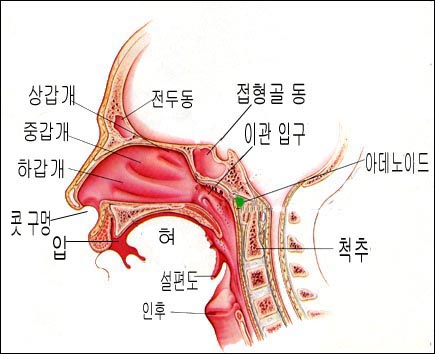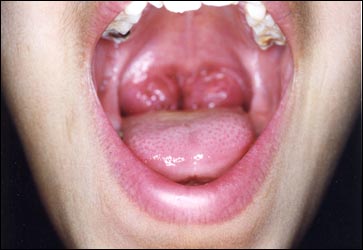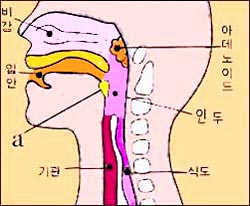폐쇄성 수면 무호흡증 증후군(차단성 수면 무호흡)과 코골이 Obstructive sleep apnea syndrome (OSAS) and snoring

그림 153. 상기도 외 그 주위 해부도.
출처-The Journal of Respiratory Diseases. Oct 1984

사진 154. 편도가 이 정도로 비대 되어 있으면 아데노이드도 함께 비대 되어 있는 것이 보통이다.
Copyright ⓒ 2011 John Sangwon Lee, MD., FAAP
- 코골이는 확실한 원인 없이 생기는 원발성 코골이와 어떤 원인으로 생기는 2차성 코골이 두 종류가 있다.
-
유아기에서 학령기까지 아이들의 7~13%에게 원발성 코골이가 생긴다.
-
잠자는 동안 상기도의 일부가 막혀 폐쇄성 무호흡증도 생길 수 있다.
-
폐쇄성 수면 무호흡증을 차단성 수면 무호흡 증후군(차단성 수면 무호흡증)이라고도 한다.
-
코를 고는 아이들의 대부분은 차단성 수면 무호흡증이 동시 생길 수 있다.
-
차단성 수면 무호흡증이 있는 아이들의 대부분은 잠을 깊이 잘 수 없고 잠을 충분히 많이 자지 못한다. 그로 인해 특히 낮에 활동 문제가 그들에게 잘 생길 수 있다.
-
때로는 그들에게 과도 활동장애 및, 또는 주의력 결핍장애가 잘 생길 수 있다.
-
차단성 수면 무호흡증으로 인해 잠을 잘 자지 못하고 또 그들의 지능지수가 더 낮아진다.
-
그들의 잠자리가 부산하고 밤에 자다가 수십 번 깰 수 있다.
-
그 정도가 심하면 이차 야뇨증, 성장지연, 심장비대, 학교공부 장애, 학습장애 등이 생길 수 있고 상기도 염에 더 자주 걸릴 수 있고 상기도 염에 걸리면 더 심하게 앓을 수 있다.
-
차단성 수면 무호흡증이 있는 아이들의 대부분의 아이들의 편도 및, 또는 아데노이드는 비정상적으로 비대되어 있는 것이 보통이다.
-
그럴 때 편도 밑 또는 아데노이드 절제 수술치료를 한 결과 85%에서 코골이가 없어지고 위에 설명한 증상 징후도 없어졌다고 한다.
-
이런 모든 징후 증상을 가지고 있는 병을 차단성 수면 무호흡증 증후군이라고 한다.
-
흡입용 스테로이드제(Budesonide) 32 마이크로그램을 비강 속에 6주 동안 뿌려 치료한 결과 차단성 수면 무호흡 증후군을 가진 아이들의 상당수의 증상 징후가 좋아졌고 편도와 아데노이드 절제수술 치료를 받지 않고 차단성 수면 무호흡 증후군이 치료됐다는 연구 결과가 나왔다.

그림 150. 상· 하기도
a-귓구멍, b-중이, c-이관, d-인두, e-후두개
Copyright ⓒ 2011 John Sangwon Lee, MD., FAAP

그림 151. 아데노이드와 상기도 해부.
Copyright ⓒ 2011 John Sangwon Lee, MD., FAAP

사진 152. 빨간색 화살표로 표시된 부위가 비대 된 아데노이드이다.
Copyright ⓒ 2011 John Sangwon Lee, MD., FAAP
Obstructive sleep apnea syndrome (OSAS) and snoring 폐쇄성 수면 무호흡증 증후군(차단성 수면 무호흡)과 코골이

Figure 153. Upper respiratory tract and surrounding anatomy. Source – The Journal of Respiratory Diseases. Oct 1984

Picture 154. If the tonsils are enlarged to this extent, it is normal that the adenoids are also enlarged. Copyright ⓒ 2011 John Sangwon Lee, MD., FAAP
• There are two types of snoring: primary snoring, which occurs without a definite cause, and secondary snoring, which occurs due to a certain cause.
• Primary snoring occurs in 7-13% of children from infancy to school age.
• Obstructive apnea can also occur when part of the upper airway is blocked while sleeping.
• Obstructive sleep apnea is also called obstructive sleep apnea syndrome (obstructive sleep apnea).
• Most children who snore can also develop blockage sleep apnea.
• Most children with obstructive sleep apnea cannot sleep deeply and do not get enough sleep. This can make them prone to activity problems, especially during the day.
• Sometimes they are predisposed to hyperactivity disorder and/or attention deficit disorder.
• Obstructive sleep apnea causes poor sleep and lower IQ.
• Their bed is bustling and they can wake up dozens of times during the night.
• If the severity is severe, secondary enuresis, growth retardation, cardiac hypertrophy, school learning difficulties, learning difficulties, etc. may occur, and upper respiratory tract infections may occur more frequently, and upper respiratory tract infections may cause severe illness.
• In most children of children with obstructive sleep apnea, the tonsils and/or adenoids are abnormally enlarged.
• In that case, as a result of subtonsillar or adenoid resection surgical treatment, snoring disappeared in 85% of cases and the symptoms described above were also eliminated.
• A disease with all these symptomatic symptoms is called obstructive sleep apnea syndrome.
• As a result of intranasal injection of 32 micrograms of an inhaled steroid (Budesonide) for 6 weeks, the symptoms of a significant number of children with obstructive sleep apnea syndrome improved. A study found that the syndrome was cured.

Figure 150. Upper and lower airways a-auricular, b-middle ear, c-ear canal, d-pharynx, e-eparynx Copyright ⓒ 2011 John Sangwon Lee, MD., FAAP

Figure 151. Adenoid and upper airway anatomy. Copyright ⓒ 2011 John Sangwon Lee, MD., FAAP

Picture 152. The area indicated by the red arrow is an enlarged adenoid. Copyright ⓒ 2011 John Sangwon Lee, MD., FAAP
출처 및 참조문헌
- www.drleepediatrics.com 제 6권 신생아 성장 발육 육아 질병
-
www.drleepediatrics.com제7권 소아청소년 감염병
- www.drleepediatrics.com제8권 소아청소년 호흡기 질환
- www.drleepediatrics.com제9권 소아청소년 소화기 질환
- www.drleepediatrics.com제10권. 소아청소년 신장 비뇨 생식기 질환
- www.drleepediatrics.com제11권. 소아청소년 심장 혈관계 질환
- www.drleepediatrics.com제12권. 소아청소년 신경 정신 질환, 행동 수면 문제
- www.drleepediatrics.com제13권. 소아청소년 혈액, 림프, 종양 질환
- www.drleepediatrics.com제14권. 소아청소년 내분비, 유전, 염색체, 대사, 희귀병
- www.drleepediatrics.com제15권. 소아청소년 알레르기, 자가 면역질환
- www.drleepediatrics.com제17권. 소아청소년 피부 질환
- www.drleepediatrics.com제18권. 소아청소년 이비인후(귀 코 인두 후두) 질환
- Red book 29th-31st edition 2021
- Nelson Text Book of Pediatrics 19th — 21st Edition
- The Johns Hopkins Hospital, The Harriet Lane Handbook, 22nd edition
-
Pediatrics A.A.P. February 2002년
-
Pediatrics, AAP, July 2002
-
Journal watch September 2008 Vol. 7 #9.
-
알레르기 비염(알러지성 비염) Allergic rhinitis
-
알레르기 비염 약물치료 Medication for allergic rhinitis
-
면역요법 Immunotherapy
-
집 먼지 좀 진드기 알레르기 House dust mite allergy
-
Childhood Emergencies in the Office, Hospital and Community, American Academy of Pediatrics
-
Emergency Medical Service for Children, By Ross Lab. May 1989. p.10
-
Emergency care, Harvey grant, and Robert Murray
-
Emergency Care Transportation of Sick and Injured American Academy of Orthopaedic Surgeons
-
Emergency Pediatrics A Guide to Ambulatory Care, Roger M. Barkin, Peter Rosen
-
Immediate care of the acutely ill and injured, Hugh E. Stephenson, Jr
-
The Critically Ill Child, Diagnosis and Management, Edited by Clement A. Smith
-
Emergency Medical Services for Children: The Role of the Primary Care Provider, America Academy of Pediatrics
-
Quick Reference To Pediatric Emergencies, Delmer J. Pascoe, M.D., Moses Grossman, M.D. with 26 contributors
-
Manual of Emergency Care
-
응급환자관리 정담미디어
-
소아가정간호백과–부모도 반의사가 되어야 한다, 이상원
-
Neonatal Resuscitation American heart Association
-
Neonatology Jeffrey J.Pomerance, C. Joan Richardson
-
Pediatric Resuscitation Pediatric Clinics of North America, Stephen M. Schexnayder, M.D.
-
Pediatric Critical Care, Pediatric Clinics of North America, James P. Orlowski, M.D.
-
Preparation for Birth. Beverly Savage and Dianna Smith
- Infectious disease of children, Saul Krugman, Samuel L Katz, Ann A. Gershon, Catherine Wilfert
-
The Harriet Lane Handbook 19th Edition
-
소아과학 대한교과서
-
제1권 소아청소년 응급의료 참조문헌과 출처
-
Other
Copyright ⓒ 2015 John Sangwon Lee, MD., FAAP
“부모도 반의사가 되어야 한다”-내용은 여러분들의 의사로부터 얻은 정보와 진료를 대신할 수 없습니다.
“The information contained in this publication should not be used as a substitute for the medical care and advice of your doctor. There may be variations in treatment that your doctor may recommend based on individual facts and circumstances. “Parental education is the best medicine.”